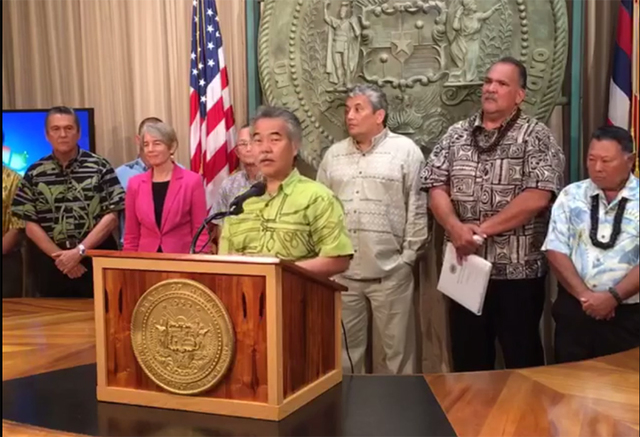HONOLULU — It takes a village — no, an entire island — to combat mosquito-borne diseases.
In a move that Gov. David Ige described as unprecedented, the mayors of four islands and other key staff flanked the state’s top executive on Thursday at a news conference in Honolulu, pledging to take mosquito control to the community with a relaunch of education efforts as Hawaii Island’s dengue outbreak disappears in the rear view mirror but the state faces the possibility of new diseases and outbreaks.
“It really demonstrates how important it is to all of us,” Ige said. “We know it’s impossible to eliminate mosquitoes here in Hawaii, but we can be proactive and ahead of the game so none of these terrible diseases become established in Hawaii.”
Mosquito-borne diseases could be the first thing on the mind of arriving visitors under a plan by the state Department of Transportation to mount “Fight The Bite” banners at exits and bag claims at the state’s five major airports. Messages on bite prevention will also appear on airport carousel monitors. The areas were chosen for high visibility to travelers, said Ross Higashi, Airports Division Deputy Director for the DOT.
Outreach within the tourism industry to workers, guest and customers is being renewed, said George Szigeti, president and CEO of the Hawaii Tourism Authority.
“We know we need to get to the hundreds of thousands of employees who represent the industry,” Szigeti said. “We all need to be engaged.”
On Oahu, the City and County of Honolulu is printing placards to be mounted on city buses detailing ways to “Fight the Bite,” and mosquito prevention handouts are being distributed around the island, Mayor Kirk Caldwell said. A public service announcement put together by the state Department of Health is set to be broadcast statewide as a reminder to the public to get rid of standing water around their property, fix windows, screen and leaky hoses, dispose of old tires and wear long-sleeve clothing and insect repellent.
Expect to hear and see the advice repeated on television, radio and around shopping areas starting this month — and in schools, according to the Hawaii Department of Education, which is working on new ways to train staff and reach students.
Riding under the surface of the discussion about bringing back the “Fight the Bite” campaign was an understanding of the damage a major tropical disease could do to tourism and the state’s economy if it became established here.
In the last six months, there have been 10 imported cases of dengue, five cases of Zika and a case of chikungunya in Hawaii. None have become locally transmitted, Department of Health Director Virginia Pressler said.
Let’s keep it that way, said Ige, who has declared the week ending July 2 as Mosquito Control Awareness Week.
Maui stood ready the moment dengue was declared on Hawaii Island, activating Civil Defense, issuing repellents, releasing public service announcements and bringing awareness campaigns to public schools, Mayor Alan Arakawa said.
“We started when it was on the Big Island, not Maui, but we knew the potential was there,” Arakawa said.
“Fight The Bite” is being described as a unified front across state and county agencies, funded partly by the state but backed by some federal funds with more anticipated once Congress decides how much it will approve of President Barack Obama’s request for nearly $2 billion to combat Zika. Under the concept of the funds being distributed to states with the highest risk, Hawaii stands to get a significant bump from federal coffers.
“Government can’t do it all by itself,” said Vern Miyagi, administrator for the Hawaii Emergency Management Agency. “Years ago, on the Big Island, we had announcements for Mosquito Sundays, when the community would focus on getting rid of standing water. We have to get back to that again.”
State and county emergency management and the DOH are finalizing a statewide plan for combating mosquito-borne diseases based on the dengue outbreak on the Big Island, Miyagi said.
“We all know what works — cooperation, collaboration and collective effort,” Hawaii Island Mayor Billy Kenoi said. “When everybody took ownership of it in our communities in partnership with state, county and federal agencies — things worked out.”
But don’t expect a redo of a county program to take tires for free at transfer stations. Kenoi explained the program was only sustainable during the time the island was fighting the dengue outbreak that ran from September 2015 to March 2016.
“Once we were able to successfully address the dengue issue, we wanted people in the community to be accountable as well,” Kenoi said. “We couldn’t possibly do an unlimited ‘bring your tire in free’ based on our capacity and budgetary challenges.”
Info: www.FightTheBiteHawaii.com



